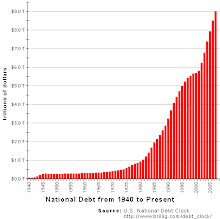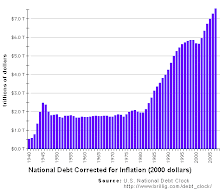Wednesday, February 13, 2008
Positive and Normative Analysis
Economics uses two types of analysis: positive and normative. Positive analysis describes the world the way it is. It is based on facts. Normative analysis describes the world the way it should be. It is based upon opinions. Economists use both types of analysis when examining social issues and advising policymakers.
Positive analysis of economic growth includes the calculation of the value of the goods and services produced and available to satisfy our needs and wants. The value of output, if measured accurately, is a fact. Positive analysis also includes discussions of ways to increase economic growth, such as increased specialization and trade or investment in physical capital, education, and technology. Simple economic models, such as those discussed in Chapter 3, illustrate these facts. Normative analysis of economic growth might suggest that taxes should be increased to provide additional funding for public schools.
Economists demonstrate that increases in education usually increase productivity. Skilled workers produce more output than unskilled workers. Since this is factual information, this is positive analysis.
People differ, however, in their opinions about how to achieve a better-educated workforce. Normative analysis might suggest that property taxes should be increased to provide more funding for public schools. This is an opinion about how to improve education. If society chooses to devote more resources to the public school system, property taxes are not the only way to generate the necessary funds. Others might prefer a different tax structure.
An alternative normative analysis might disagree with the presumption that increased spending on public schools will automatically improve the quality of education. This is the basis behind President George W. Bush’s initiatives that require students to pass competency examinations before promotion to the next school grade level. Since this part of the analysis is based on opinions about the best way to improve education, it is normative.
A similar distinction between positive and normative analysis can be made when discussing the macroeconomic policy goal of low unemployment. Economists at the U.S. Bureau of Labor Statistics (BLS) regularly report on the condition of the U.S. labor market. Their calculations of the number of adults who are unemployed and the percentage of the labor force that wants a job but is unable to find one are examples of positive economic analysis since they are based on facts. Normative analysis might suggest that the current unemployment rate is too high and that the government should take steps to reduce unemployment. Whether the current unemployment rate is too high is a matter of opinion.
Similarly, positive analysis of inflation includes the calculation of the rate at which prices are rising, while normative analysis might suggest that the inflation rate is too high and the government should attempt to correct it.
Positive analysis of monetary policy includes a discussion of the ways the Federal Reserve System affects the economy by influencing the amount of money banks create when they issue loans. Normative analysis might suggest the Fed should do more to stimulate overall spending in the economy.
Positive analysis of fiscal policy includes a discussion of the various taxes that are used to generate revenue for the government and the ways that money is spent to provide goods and services for the public. Normative analysis might suggest that the current tax system is inefficient or unfair or proclaim that the government spends too much money on certain programs and too little on others.
Politicians often use economists as hired guns. Rather than asking economists to provide an independent analysis of a policy issue, they instead tell the economists their position on a social issue and ask economists to provide them with supporting research. This frequently results in the public being given a partial analysis, with unfavorable aspects ignored or downplayed. Politicians may also hire economists to present opinions as if they were facts. Thus it is important to be able to distinguish between positive and normative analysis when evaluating economic arguments.
Positive analysis of economic growth includes the calculation of the value of the goods and services produced and available to satisfy our needs and wants. The value of output, if measured accurately, is a fact. Positive analysis also includes discussions of ways to increase economic growth, such as increased specialization and trade or investment in physical capital, education, and technology. Simple economic models, such as those discussed in Chapter 3, illustrate these facts. Normative analysis of economic growth might suggest that taxes should be increased to provide additional funding for public schools.
Economists demonstrate that increases in education usually increase productivity. Skilled workers produce more output than unskilled workers. Since this is factual information, this is positive analysis.
People differ, however, in their opinions about how to achieve a better-educated workforce. Normative analysis might suggest that property taxes should be increased to provide more funding for public schools. This is an opinion about how to improve education. If society chooses to devote more resources to the public school system, property taxes are not the only way to generate the necessary funds. Others might prefer a different tax structure.
An alternative normative analysis might disagree with the presumption that increased spending on public schools will automatically improve the quality of education. This is the basis behind President George W. Bush’s initiatives that require students to pass competency examinations before promotion to the next school grade level. Since this part of the analysis is based on opinions about the best way to improve education, it is normative.
A similar distinction between positive and normative analysis can be made when discussing the macroeconomic policy goal of low unemployment. Economists at the U.S. Bureau of Labor Statistics (BLS) regularly report on the condition of the U.S. labor market. Their calculations of the number of adults who are unemployed and the percentage of the labor force that wants a job but is unable to find one are examples of positive economic analysis since they are based on facts. Normative analysis might suggest that the current unemployment rate is too high and that the government should take steps to reduce unemployment. Whether the current unemployment rate is too high is a matter of opinion.
Similarly, positive analysis of inflation includes the calculation of the rate at which prices are rising, while normative analysis might suggest that the inflation rate is too high and the government should attempt to correct it.
Positive analysis of monetary policy includes a discussion of the ways the Federal Reserve System affects the economy by influencing the amount of money banks create when they issue loans. Normative analysis might suggest the Fed should do more to stimulate overall spending in the economy.
Positive analysis of fiscal policy includes a discussion of the various taxes that are used to generate revenue for the government and the ways that money is spent to provide goods and services for the public. Normative analysis might suggest that the current tax system is inefficient or unfair or proclaim that the government spends too much money on certain programs and too little on others.
Politicians often use economists as hired guns. Rather than asking economists to provide an independent analysis of a policy issue, they instead tell the economists their position on a social issue and ask economists to provide them with supporting research. This frequently results in the public being given a partial analysis, with unfavorable aspects ignored or downplayed. Politicians may also hire economists to present opinions as if they were facts. Thus it is important to be able to distinguish between positive and normative analysis when evaluating economic arguments.
Subscribe to:
Post Comments (Atom)






Interesting analysis.
ReplyDeleteGet question bank from here Question Paper of Macro Economics | BBS 2nd year 2074 | 4 Years Program
ReplyDelete